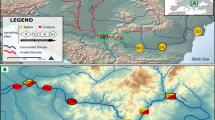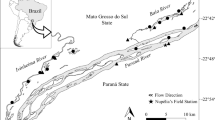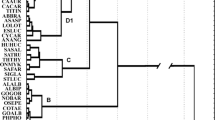Abstract
Invasive species impacts on native species and communities have been widely recognised for decades and may involve important economical losses. In this study, we examined two marine muricid gastropods: an invader, Ocinebrellus inornatus, and a resident, Ocenebra erinacea. Both species co-occur on French Atlantic coasts and probably have economical impacts on oyster farming areas of the Charente-Maritime region of France. In previous studies, we investigated the introduction source and the expansion patterns of O. inornatus, using molecular markers. However, these studies are not sufficient to fully understand the expansion dynamics of the exotics. The present framework is devoted to comparing life-history traits between the introduced and resident species. Our results first showed that O. inornatus has more favourable traits, such as a better mean growth rate and a higher reproductive effort, in comparison with O. erinacea. These traits may explain the invader establishment and, partly, its spread along the coast of France. Secondly, the resident species drilled a higher rate of oysters than the invader. Finally, the establishment of O. inornatus in France does not seem to be at the expense of O. erinacea because: (1) resources are not limiting in oyster farming areas and (2) there does not appear to be competition by interference between the species.





Similar content being viewed by others
References
Amarasekare P (2002) Interference competition and species coexistence. Proc R Soc Lond Ser B Biol Sci 269:2541–2550
Berman J, Carlton JT (1991) Marine invasion processes: interactions between native and introduced marsh snails. J Exp Mar Biol Ecol 150:267–281
Bohonak AJ (1999) Dispersal, gene flow, and population structure. Q Rev Biol 74:21–45
Brenchley GA, Carlton JT (1983) Competitive displacement of native mud snails by introduced periwinkles in the New England intertidal zone. Biol Bull (Woods Hole) 165:543–558
Byers JE (2000a) Competition between two estuarine snails: implications for invasions of exotic species. Ecology 81:1225–1239
Byers JE (2000b) Effects of body size and resource availability on dispersal in a native and a non-native estuarine snail. J Exp Mar Biol Ecol 248:133–150
Byston T, Garcia-Berthon E (1999) Density dependent growth and size specific competitive interactions in young fish. Oikos 86:217–232
Carlton JT (1992) Introduced marine and estuarine mollusks of North America: an end-of-the-20th-century perspective. J Shellfish Res 11:489–505
Case TJ, Taper ML (2000) Interspecific competition, environmental gradients, gene flow and the coevolution of species borders. Am Nat 155:583–605
Chow V (1987) Patterns of growth and energy allocation in northern California populations of Littorina (Gastropoda: Prosobranchia). J Exp Mar Biol Ecol 110:69–89
Cloern JE, Nichols FH (1978) A von Bertalanffy growth model with a seasonally varying coefficent. J Fish Board Res Can 35:1479–1482
Crawley MJ (1986) The population biology of invaders. Philos Trans R Soc Lond B Biol Sci 314:711–731
de Montaudouin X, Sauriau PG (2000) Contribution to a synopsis of marine species richness in the Pertuis Charentais Sea with new insights in soft-bottom macrofauna of the Marennes-Oléron Bay. Cah Biol Mar 41:181–222
Duncan RP, Bomford M, Forsyth DM, Conibear L (2001) High predictability in introduction outcomes and the geographical range of introduced Australian birds: a role for climate. J Anim Ecol 70:621–632
Ehrlich PR (1989) Attributes of invaders and the invading process: vertebrates. In: Drake JA, Mooney HA, Di Castri F, Groves RH, Kruger M, Rejmánek M, Williamson M (eds) Biological invasions: a global perspective. Wiley, New York, pp 315–328
Elton CS (1958) The ecology of invasions by animals and plants. Methuen, London
Frank PW (1969) Growth rates and longevity of some gastropods mollusks on the coral reef at Heron Island. Oecologia 5:232–250
Fretter V, Graham A (1962) British prosobranch molluscs, their functional anatomy and ecology. Ray Society, London
Galtsoff PS (1929) Oyster industry of the Pacific coasts of the United States. Rep. US Commission Fish., App. VIII. Bur Fish Doc 1066:367-400
Garcia-Meunier P, Martel C, Pigeot J, Chevalier G, Blanchard G, Goulletquer P, Robert S, Sauriau PG (2002) Recent invasion of the Japanese oyster drill along the French Atlantic coast: identification of specific molecular markers that differentiate Japanese, Ocinebrellus inornatus, and European, Ocenebra erinacea, oyster drills. Aquat Living Resour 15:67–71
Gibbs PE (1996) Oviduct malformation as a sterilising effect of tributyltin (TBT)-induced imposex in Ocenebra erinacea (Gastropoda: Muricidae). J Molluscan Stud 62:403–413
Goulletquer P, Bachelet G, Sauriau PG, Noël P (2002) Open Atlantic coast of Europe—a century of introduced species into French waters. In: Leppäkoski E, Gollash S, Olenin S (eds) Invasive aquatic species of Europe—Distribution, impacts and management. Kluwer, Dordrecht, pp 276–290
Grosholz ED (1996) Contrasting rates of spread for introduced species in terrestrial and marine systems. Ecology 77:1680–1686
Grosholz ED (2002) Ecological and evolutionary consequences of coastal invasions. Trends Ecol Evol 17:22–27
Hasselbald V (1966) Estimation of parameters for a mixture of normal distributions. Technometrics 3:431–446
Jablonski D (1996) Body size and macroevolution. In: Jablonski D, Erwin DH, Lipps JH (ed) Evolutionary paleobiology. University of Chicago Press, Chicago, pp 256–289
Kohn AJ (1968) Microhabitats, abundance and food of Conus on the atoll reefs in the Maldive and Chagos Islands. Ecology 49:1046–1062
Kolar CS, Lodge DM (2001) Progress in invasion biology: predicting invaders. Trends Ecol Evol 16:199–204
Lodge DM (1993) Biological invasions: lessons for ecology. Trends Ecol Evol 8:133–137
Lonsdale WM (1999) Global patterns of plant invasions and the concept of plant invasibility. Ecology 80:1522–1536
Loreau M, Ebenhoen W (1994) Competitive exclusion and coexistence of species with complex life cycles. Theor Popul Biol 46:58–77
Lovette IJ, Seutin G, Ricklefs RE, Bermingham E (1999) The assembly of an island fauna by natural invasion: sources and temporal patterns in the avian colonization of Barbados. Biol Investig 1:33–41
Martel C, Viard F, Bourguet D, Garcia-Meunier P (2004a) Invasion by the marine gastropod Ocinebrellus inornatus in France. I. Scenario for the source of introduction. J Exp Mar Biol Ecol (in press)
Martel C, Viard F, Bourguet D, Garcia-Meunier P (2004b) Invasion by the marine gastropod Ocinebrellus inornatus in France. II. Expansion along the Atlantic coast. Mar Ecol Prog Ser (in press)
McLeod Chapman WB, Banner AH (1949) Contributions to the life history of the Japanese oyster drill, Tritonalia japonica, with notes on other enemies of the Olympia oyster, Ostrea lurida . Biol Bull (Woods Hole) 49:167–200
Miller AW, Hewitt CL, Ruiz GM (2002) Invasion success: does size really matter? Ecol Lett 5:159–162
Moyle PB (1986) Fish introductions in North America: patterns and ecological impact. In: Mooney HA (ed) Ecology of biological invasions of North America end Hawaii. Springer, New York Berlin Heidelberg, pp 27–43
Nelder VA, Mead R (1965) A Simplex method for function minimization. Comput J 7:308–313
Newsome AE, Noble IR (1986) Ecological and physiological characters of invading species. In: Groves RH, Burton JJ (eds) Ecology of biological invasions. Cambridge University Press, Cambridge, pp 1–20
Pigeot J, Miramand P, Garcia-Meunier P, Seguignes M (2000) Présence d’un nouveau prédateur de l’huître creuse, Ocinebrellus inornatus (Récluz, 1851), dans le bassin conchylicole de Marennes-Oléron. CR Acad Sci Ser III Sci Vie 323:697–703
Pimentel D, Lach L, Zuniga R, Morrison D (2000) Environmental and economic costs of nonindigenous species in the United States. BioScience 50:53–65
Race MS (1982) Competitive displacement and predation between introduced and native mud snails. Oecologia 54:337–347
Rawlings TA (1995) Direct observation of encapsuled development in muricid gastropods. Veliger 38:54–60
Réjmanek M (1996) What attributes make some plant species more invasive? Ecology 77:1655–1661
Sakai AK, Allendorf FW, Holt JS, Lodge DM, Molofsky J, With KA, Baughman S, Cabin RJ, Cohen JE, Ellstrand NC, McCauley DE, O’Neil P, Parker IM, Thompson JN, Weller SG (2001) The population biology of invasive species. Annu Rev Ecol Syst 3:305–332
Sala OE, Chapin FS, Armesto JJ, Berlow E, Bloomfield J (2000) Global biodiversity scenarios for the year 2100. Science 287:1770–1774
Sanders NJ, Goteli NJ, Heller NE, Gordon DM (2003) Community disassembly by an invasive species. Proc Natl Acad Sci USA 100:2474–2477
Sauriau PG (1991) Spread of Cyclope neritea (Mollusca: Gastropoda) along the north-eastern Atlantic coasts in relation to oyster culture and to climatic fluctuations. Mar Biol 109:299–309
Schiffman PM (1997) Animal-mediated dispersal and disturbance: driving forces behind alien plant naturalization. In: Luken JO, Thieret JW (eds) Assessment and management of plant invasions. Springer, New York Heidelberg Berlin, pp 87–94
Shea K, Chesson P (2002) Community ecology theory as a framework for biological invasions. Trends Ecol Evol 17:170–176
Sher AA, Hyatt LA (1999) The distributed resource–flux invasion matrix: a new framework for patterns of plant invasions. Biol Investig 1:107–114
Simberloff D (1996) Impacts of introduced species in the United States. Consequences 2:13–23
Skilleter GA, Underwood AJ (1993) Intra- and inter-specific competition for food in infaunal coral reef gastropods. J Exp Mar Biol Ecol 173:29–55
Sokal RR, Rohlf FJ (1981) Biometry. Freeman, New York
Stein B, Kutner LS, Adams JS (2000) Precious heritage: the status of biodiversity in the United States. Oxford University Press, Oxford
Tokeshi M (1999) Species coexistence: ecological and evolutionary perspectives. Oxford University Press, Oxford
Tomlinson PK (1970) Program NORMSEP. The resources agency, California Dept. of Fisheries and Game, Sacramento
Tsutsui ND, Suarez AV, Holway DA, Case TJ (2001) Relationships among native and introduced populations of the Argentine ant (Linepithema humile) and the source of introduced populations. Mol Ecol 10:2151–2161
Vermeij GT (1996) An agenda for invasion biology. Biol Conserv 78:3–9
Webber HH (1977) Reproduction of marine invertebrates. Molluscs: gastropods and cephalopods. In: Giese AC (ed) Gastropoda: Prosobranchia. Academic, New York, pp 1–97
Whitlatch RB, Obrebski S (1980) Feeding selectivity and coexistence in two deposit-feeding gastropods. Mar Biol 58:219–225
Williamson M (1996) Biological invasions. Chapman and Hall, London
Yamaguchi M (1977) Shell growth and mortality rates in the coral reef gastropod Cerithium nodulosum in Pago Bay, Guam, Mariana Islands. Mar Biol 44:249–263
Acknowledgements
The authors are grateful to the Laboratoire Conchylicole de Poitou-Charentes (IFREMER—La Tremblade) for technical assistance; K. Grangeré, C. Mercier, D. Fichet and G. Chevalier for helping on surveys. C. Martel acknowledges a PhD grant from the Ministère de l’Education Supérieure et de la Recherche. This study was supported by the Conseil Général de Charente-Maritime and by the Ministère de l’Ecologie et du Développement Durable (Program INVABIO, project no. D4E/SRP/01115). The experiments comply with the current laws of the country in which the experiments were performed.
Author information
Authors and Affiliations
Corresponding author
Additional information
Communicated by O. Kinne, Oldendorf/Luhe
Rights and permissions
About this article
Cite this article
Martel, C., Guarini, J.M., Blanchard, G. et al. Invasion by the marine gastropod Ocinebrellus inornatus in France. III. Comparison of biological traits with the resident species Ocenebra erinacea. Marine Biology 146, 93–102 (2004). https://doi.org/10.1007/s00227-004-1421-8
Received:
Accepted:
Published:
Issue Date:
DOI: https://doi.org/10.1007/s00227-004-1421-8




